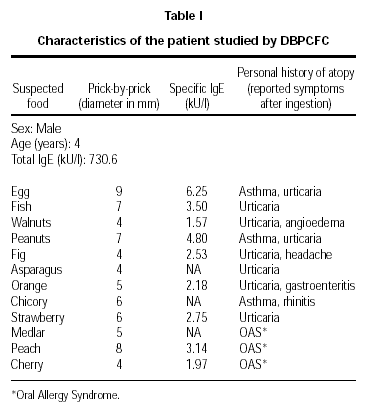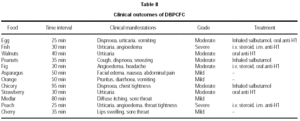INTRODUCTION
Food allergy is quite common in children and it usually trends to improve with ageing. Clinical manifestations include acute allergic reactions such as urticaria, angioedema, vomiting, laryngeal oedema, bronchospasm, hypotension, oral allergy syndrome (OAS) and chronic manifestations such as diarrhoea and eczema (1). Eggs, milk and peanuts are the most frequent responsible for the clinical manifestations in paediatric patients. Usually one or two allergens are responsible for symptoms and their avoidance is sufficient to control symptoms. When an individual has specific IgE to a large variety of foods (multifood allergy), the clinical picture may be of remarkable severity and the avoidance of the offending foods may lead to severe dietary impairment. We describe herein the case of a child with ascertained multifood allergy.
CASE REPORT
A.C., male, 4 yrs old, began suffering from urticaria and asthma clearly related to the ingestion of eggs at the age of 2. In the subsequent years, rhinitis, angioedema, headache, gastro-enteritis appeared. These symptoms were variously associated and started between few minutes and 2 hours after the ingestion of several foods. The parents of the child were interviewed in detail in order to assess which foods were likely responsible for the symptoms. Based on the clinical history, some foods were strongly suspected: egg, fish, peanuts, walnut, fig, asparagus, orange, chicory, medlar, peach, strawberry and cherry. At the time of referral to our clinic, the child had important dietary limitations.
A panel of prick-by-prick tests with fresh foods, including those clearly suspected plus other ones (i.e. meat, milk, soybean, apple, tomato, carrot, apple), was firstly settled up. Patient was tested on the volar surface of the distal forearm with all allergens. After cutting the foods, the lancet was pricked into the fresh material and then immediately into the skin of the patient. NaCl 0.9 % and histamine hydrochloride 10 mg/ml were used as negative and positive control, respectively. Wheals were read after 15 minutes and wheal reactions were outlined with a fine point marker and transferred to paper with transparent tape. A skin test was considered positive if the diameter of the wheal was greater than 3 mm, with respect to negative control (2). The procedure evidenced a skin positivity for eggs, fish, peanut, walnut, asparagus, chicory, medlar, peach, strawberry, orange, fig and cherry. In contrast, the standard skin prick tests with common aeroallergens were completely negative (data not shown). In parallel, a RAST assay (CAP System, Pharmacia, Uppsala, Sweden) was performed with the commercially available extracts and it confirmed the presence of specific IgE to the majority of suspected foods, as shown in table 1. Values corresponding to at least Class 2 (i.e. specific IgE ≥ 0.35 kU/l) were considered as positive. The total serum IgE was 730.6 kU/l (normal value < 100 kU/l).
FOOD CHALLENGES
After having obtained the informed consent from the child's parents, a double blind placebo controlled food challenge (DBPCFC) was carried out as next step, using dehydrated food in capsules or diluted in liquid. Each DBPCFC was performed on one day. Due to practical reasons, asparagus, chicory and medlar were masked in bread. The placebos were dextrose and normal baked bread. Medical assistance and resuscitation facilities were available during the whole challenge procedures. Administration of the suspected food took place every 20 minutes, doubling the amount given each time until the total amount of 10 g. of food was reached, or until the patient developed clinical manifestations. The starting dose and the total amount of food administered during each challenge were calculated on the basis of the amount of food that had caused the adverse reaction (3). Neither the doctor nor the nurse performing the challenges knew whether placebo or food was being given to the patient. The DBPCFC was positive, at various degrees, for all tested foods in accordance to skin sensitizations.
The results of the mentioned diagnostic procedures are summarized in table II.
DISCUSSION
Food allergy (FA) corresponds to clinical manifestations related to sensitisation to food proteins (4,5). Nowadays, the emphasis has been mainly placed on the IgE dependent mechanisms (6). The diagnosis is established in two stages. The first demonstrates an immediate sensitisation with skin prick tests and determination of specific IgE in the blood. The second requires standardised oral challenge tests. This methodology is the object of a wide consensus on the basis of homogeneous published study (7, 8). The growing number of publications devoted to F. A. may partly reflect increasing interest in the prevalence of pathologies related to it. However, it is undeniable that the profound changes in the modern eating habits, resulting from the variety of food sources and the large role played by agronomic and food technologies, are responsible for a real increase (9, 10). It is frequent in the clinical practice to find out multiple skin sensitisation or RAST positivities to foods, but usually, the majority of these sensitisations have no clinical relevance and the offending foods are few. Multifood allergy is thought to occur mainly in infants (11) and anyway it represents a controversial diagnosis, since multiple confounding factors (chemicals or inhalant allergens) can intervene as previously described (12). In the present case, a true multifood allergy was present, since the child was allergic to 12 different foods. The causal role of the foods was confirmed by the DBPCFC and an IgE-mediated mechanism could be envisaged based on the results of skin test and RAST assay. Fortunately, the patient could tolerate wheat, milk, meat and many vegetables, which are main components of the Mediterranean diet so that, by carefully avoiding the causative foods, he could achieve a normal growth pattern.
Hopefully our patient with time should become tolerant to at least some offending foods. Based on this experience we advice that in the case of multiple symptoms attributable to ingestion of various food in infants and children, a detailed diagnostic procedure including DBPCFC should be performed (13-15), since an incorrect etiological diagnosis can lead to nutritional problems.








